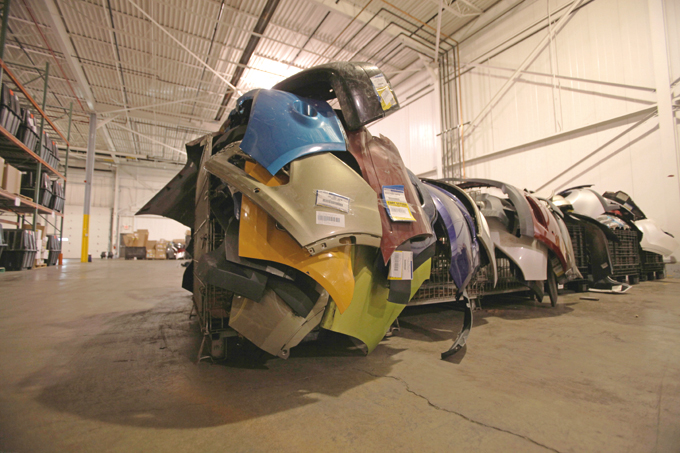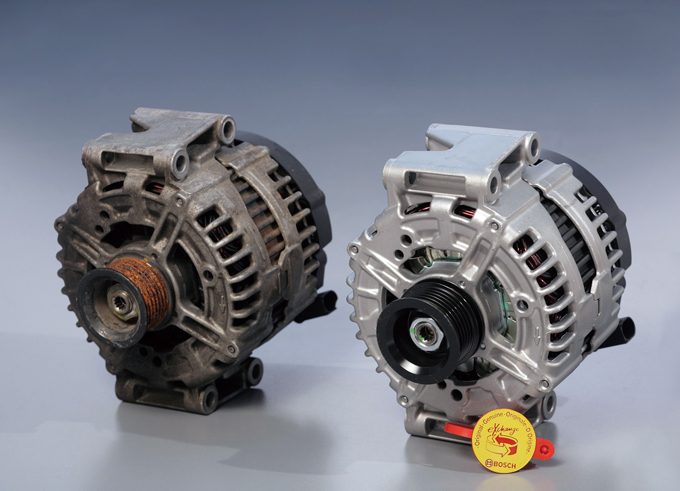Automakers and Tier-1s Embrace a Remanufactured Future
Industry whittles down crash-to-trash habits as environmental demands rise
2013/04/10 | By Quincy LiangGlobal automakers and tier-one parts vendors are heeding the 3R mantra (recycle, reuse and reduce) in growing numbers, fueling a rise in the parts remanufacturing business at a time when the automotive industry is challenged to make its products and practices greener.
American automaker Ford Motor Co. recently claimed that its recycling and remanufacturing program has kept 120 million pounds of damaged vehicle parts from landfills since 2003, effectively ending the days when the crack of a headlamp or crunch of a bumper would render useless such components.
Ford's Core Recovery Program oversees collection, remanufacturing and recycling of damaged parts—everything from small sensors and fuel injectors to large engine parts—from Ford vehicles that have been repaired through the company's dealer network.
Several issues necessitated the program, Ford says, from more complex and expensive parts in cars and trucks to a need to get more control over the sales of aftermarket components to a need to recycle more.
Bumpers & Headlights
The automaker says that in the last two years, bumpers and headlights were added to the list. In the short time since, about 62,000 bumpers have been collected while about 26,000 headlights have been recycled.
A senior official at Ford says that most parts that come back to his company through the program still have a lot of life left. Even more important, however, he adds, is that Ford strongly believes it's just the right thing to do from an environmental perspective.
Ford, in fact, has remanufactured parts for decades, but it formed the Core Recovery Program in 2003. The impetus was that there were too many different collection methods being used in various parts of the company, making it too hard and confusing for all the parties involved—from the dealers to those managing Ford's supply chain.
General recycling awareness has increased, too. The U.S. Environmental Protection Administration (EPA) reports that in 2010 recycling helped keep 85 million tons of material from being disposed of in landfills—up from 15 million tons in 1980. Other factors led to the creation of the Core Recovery Program for vehicle components, for example, have become increasingly complex and expensive, making it more important than ever to recycle and reuse parts whenever possible, Ford explains.
Take headlight. About 15 years ago, headlights were pretty basic because they often consisted mostly of a bulb, a glass lens and a reflector. Now, typical headlight assemblies are almost two feet wide and have become a major part of the vehicle, both in terms of design and function—consisting of not just a few parts, but expensive plastics, advanced bulb technology, additional wiring harnesses and more.
In fact, Ford claims, more than 85% of each Ford vehicle today is recyclable, with more and more parts being kept from landfills. Bumpers, for example, are now collected and sent to a third party where they are processed into pellets that can then be used to make brand-new products. Since 2010, about 62,000 bumpers have been recycled through the program.

Ford Case
In the automaker's case, dealers pay a core charge on each new part bought from Ford to replace a damaged one. When the original damaged part is returned to Ford, the dealer gets the money from the core charge back—operating exactly like bottle return systems do in some parts of the United States.
To collect the damaged and broken parts from dealers, Ford works with distributors strategically located around the country. The 35,000-square-foot center serves as the central collection point for Ford dealers in Southeast Michigan, Ohio and Indiana. Ford uses a proprietary system involving bar codes and scanners to keep track of every single part collected. Once collected, each part is evaluated for either recycling or remanufacturing potential. Parts recycled are sent to third-party processors and the raw material is resold.
When parts are remanufactured, they are cleaned, machined and tested to meet Ford quality standards. Like the raw material that comes from recycling, the parts that are remanufactured can then be sold or used in new applications. In the rare instances when recycling or remanufacturing is not an option, Ford ensures proper disposal.
A parts-recycling partner of Ford says that whether parts are recycled or remanufactured, the Core Recovery Program has been profitable for Ford—and that it could grow even more.

Bosch Case
International tier-1 automotive supplier Bosch is another paradigm in parts recycling and remanufacturing. The firm is a leading provider of industrially remanufactured vehicle parts and its exchange parts program is represented locally within all global markets.
Bosch's exchange parts program comprises some 11,000 vehicle parts across 30 product groups, such as starter motors, alternators, A/C (air conditioner) compressors, brake calipers, ignition distributors and diesel injection pumps. Bosch also offers an extensive range of components and products for remanufacturing.
Additionally, the Bosch Electronic Service provides a wide range of repair options for control units and car multimedia systems. These are reconditioned or repaired to Bosch quality standards.
Increasing Quantity of Remanufactured Parts on the Market
Over the last few years, the demand for high-quality remanufactured parts for vehicle repairs has increased internationally, Bosch says. Today, the exchange market in the United States has a share of almost 90%. The market segment is also continuing to expand in Europe and at a considerably higher growth rate than the parts market as a whole.
Bosch expects that the remanufacturing market will grow to 30 million products per year in Europe by 2015. Bosch also calculates that there will be growth in the field of system and component maintenance for hybrid and electric drives. The hybrid and electric drives segment is an area in which Bosch offers a comprehensive original equipment (OE) product portfolio, while also considering the ability to repair these products as early as the development stage.
1st-Class Quality Used Parts
In Bosch's recycling program, workshops doing vehicle repair can choose whether to replace a defective part with a new part or a remanufactured part. For owners of older vehicles in particular, it is often not worth purchasing new components. A remanufactured part costs the end customer around 30% to 40% less than a new part—with the same two-year warranty. Bosch applies the same high quality standards to remanufactured parts as it does to the manufacture of new parts. For the global remanufacturing business, the industry standards are not regulated yet. Bosch supports various initiatives to establish uniform quality standards.
Exchange Parts Protect the Environment and Prevent CO2 Emissions
In addition to cost efficiency, environmental protection and the conservation of resources are also good reasons to use remanufactured parts in value-driven vehicle repairs.
Remanufacturing of starters and alternators has been carried out at the Bosch plant in Gottingen since 1965, the company says. Remanufacturing of used parts requires less energy than manufacturing new parts. In 2010, Bosch remanufactured 3.3 million parts, reducing its CO2 emissions by 23,000 metric tons in comparison to the figures produced if new parts had been manufactured. Studies have shown that, on average, one hectare of forest absorbs of 13 tons of CO2 each year—the 23,000 metric tons of CO2 saved by Bosch is therefore equivalent to a forest area covering 1,923 hectares.
Global Range with Regional Structures
Working with exchange parts requires goods to flow in two directions, making the whole process that bit more complicated. It requires that the correct exchange part be sent to the vehicle parts dealer or workshop as quickly as possible and that the used part be quickly and reliably sent to the re-manufacturers, Bosch stresses.
Regional structures are therefore required to ensure the process runs smoothly. Bosch processes the exchange parts within a global network. As the market leader this means Bosch is able to provide parts dealers and vehicle workshops worldwide with an extensive range of products for exchange vehicle parts from a local source.
The simple, well-organized refund system for returns implemented by Bosch ensures the whole process runs as smoothly as possible. A fast and reliable procedure is guaranteed by providing clear return conditions and implementing the "back-in-box" process of returning the used parts in the original packaging provided with the exchange part. This also means that the packaging is not disposed of but re-used. Returning the used parts being replaced in the original packaging also protects the part during transportation. Catalogs in various languages covering the full program, together with a detailed returns list, enable the customer to easily identify the exchange part required, the tier-one says.
9,000 Parts from 27 Product Groups
More and more workshops are opting for remanufactured Bosch products to keep repair costs in line with a vehicle's current value. This remanufacturing process is now applied to around 9,000 vehicle parts from 27 product groups.
This process of remanufacturing vehicle parts is not just a cheaper alternative for end customers, Bosch stresses, but also protects the environment by reusing much of the original product. Consequently, this system cuts down on the use of raw materials and produces lower CO2 emissions than would be generated by the production of new parts, the company says.

